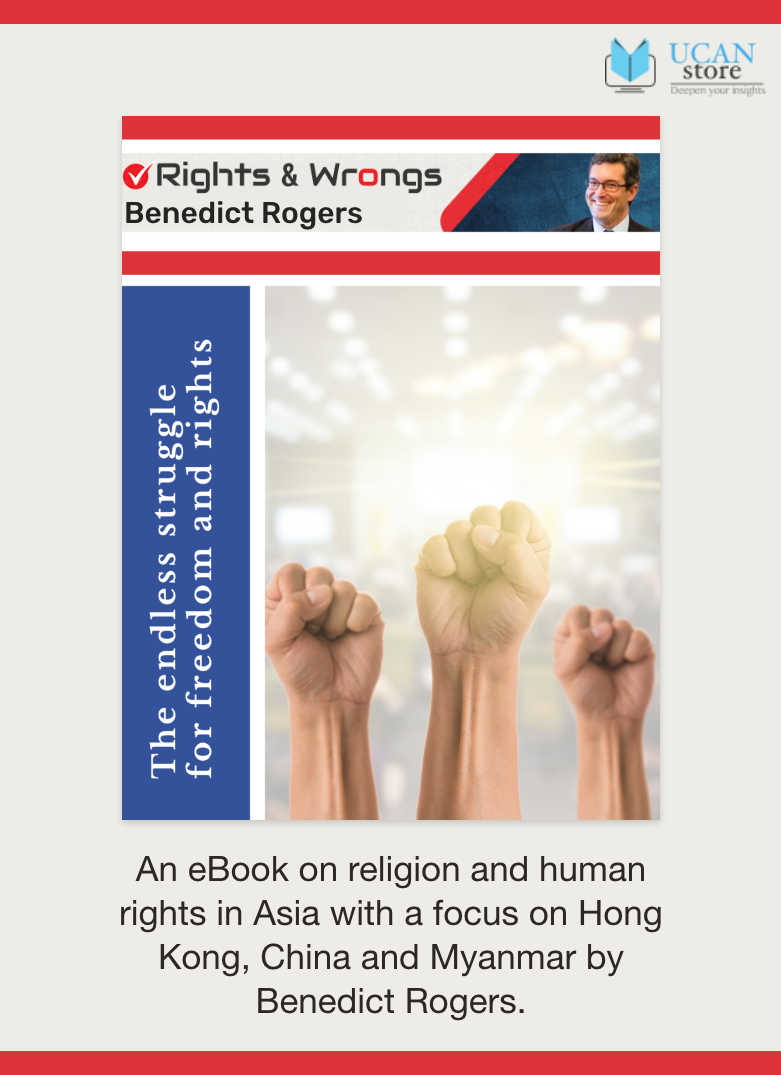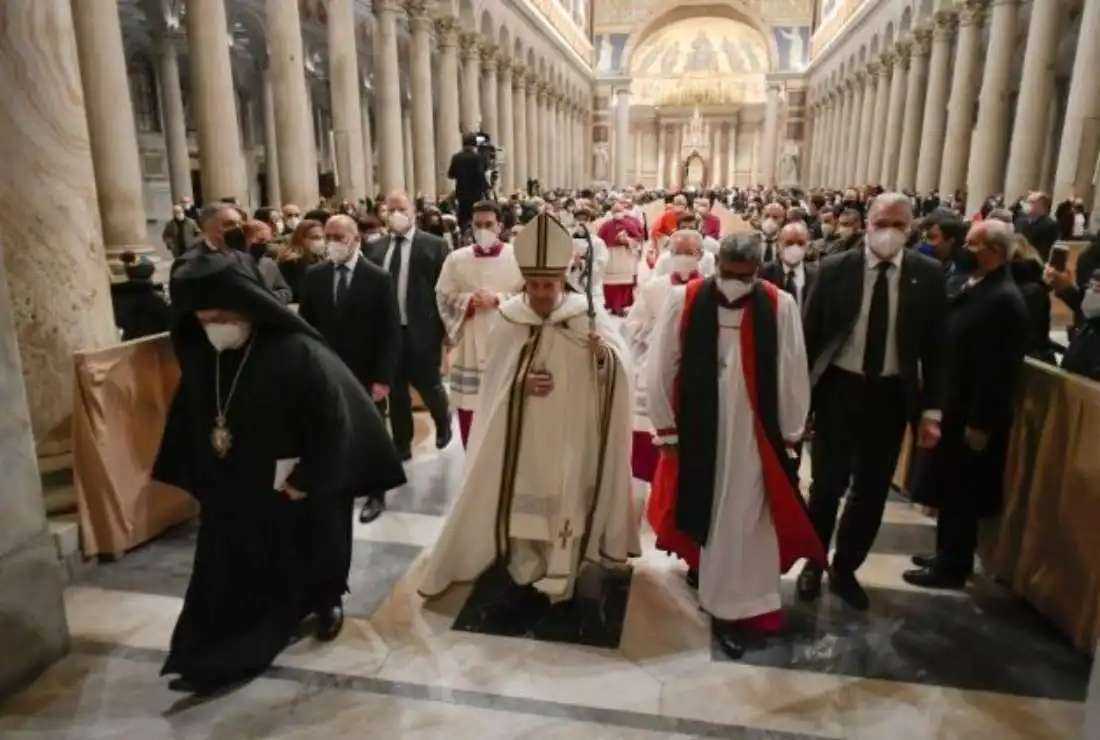
Their encounter is never a mere face-to-face that could be limited to theological considerations

Pope Francis with ecumenical leaders at Vespers for the conclusion of the Week of Prayer for Christian Unity in 2022. (Photo: Vatican Media)
In this week of prayer for Christian unity, we are called to pay attention to the diversity of Christians as well as to their mutual relations. We explore here some of the ways through which Asian Catholics respond to the presence of evangelical Christians.
But before focusing on the Catholic-Evangelical encounter, we must first consider the immense diversity of ecclesial, political, and socio-economic situations that Asia represents. Depending on whether we look at Japan, Pakistan, the Philippines, or Bhutan, the socio-economic context, the local history, the vitality of local Churches, and their mutual relations vary tremendously.
To understand this diversity with more accuracy, let us focus on East Asia first.
In Japan, a prosperous country where the modernity of the Edo period was partially built against Christianity, churchgoers are rare. Christian communities are mostly isolated and surrounded by a Shinto world. In this overwhelming environment, relations between Catholics and Evangelicals are characterized by their scarcity.
"A significant proportion of the “newly” baptized Korean Catholics are often former Protestants tired of the internal quarrels"
In South Korea, however, the situation is different. If the peninsula shares socio-economic similarities with Japan, Korean Christians represent almost a third of the population. Since the Second World War, their numbers have increased sharply and Protestants, largely Presbyterian Evangelicals, represent 19 percent of the population.
In a context of great religious freedom with numerous conversions, Korean Churches have long competed against each other. In this intense religious competition, Catholics and Evangelicals are usually in opposition. Relations between the two are bad and critics harsh. Mutual incomprehension and disdain are rather the norm.
However, on the Catholic side, we cannot forget that a significant proportion of the “newly” baptized Korean Catholics are often former Protestants tired of the internal quarrels and radicalism so typical of Korean Protestantism. Therefore, the reception of the other does not take place at the theological or discursive levels, nor through cooperation between Churches, but in the quiet integration of new Catholics who have been initiated into the Christian faith by evangelical Churches.
If we continue our journey slightly further west, relations between Chinese Catholics and Evangelicals are again different. In this huge country, Christians represent only 3 percent of the population.
In China, Catholicism has long been concerned with survival. In the face of an adverse political regime, Catholics have learned to operate within the intimacy of family circles. Although this is changing quickly, their relations with Evangelicals have been almost non-existent, and if any, suspicious.
Moreover, in China, as in many parts of the continent, many Protestant Churches — especially House Churches which operate as semi-clandestine entities — have been deeply influenced by North American evangelicalism and its unquestioned anti-Catholicism. If real bridges exist between Chinese Catholics and registered Protestant Churches which both must work with state officials, relations between Catholics and Evangelicals are very rare and difficult.
"In the Philippines, as in other regions of the continent, a real cross-fertilization exists and that some sort of pan-Evangelico-Catholicism emerges"
It is quite different in the Philippines. While the country is traditionally the Catholic stronghold of Asia, the situation is rapidly changing. If a certain popular Catholicism continues to shape the national identity, many faithful are taking critical distance vis-à-vis the ecclesial authorities and demonstrate a growing skepticism toward their socio-political role.
A growing number of Filipino Catholics go back and forth between different Churches, Catholic or not. They learn from different traditions and, sometimes, they identify with evangelical ones. Through these circulations, the Catholic universe of the Philippines is increasingly influenced by evangelical sensibilities, and vice versa, remodeling liturgical style, ecclesial norms, and missionary ideology of the archipelago. We can therefore say that in the Philippines, as in other regions of the continent, a real cross-fertilization exists and that some sort of pan-Evangelico-Catholicism emerges.
But this quick survey across East Asia should not make us believe that the national scale could be enough. Within a single country, local dynamics and power relations may vary from one region to another.
For example, on the island of Taiwan, there are three regions with three very different dynamics that affect the way Catholics interact, perceive, and eventually welcome Evangelical traditions. On the eastern part of the island, aboriginal ethnic groups are the vast majority of the population and, usually, they are Christians. There, Evangelicals and Catholics have the opportunity to mix and cooperate at the village level. Through family ties and the traditional structures of the village, they cultivate a relative fraternity and mutual benevolence.
Nevertheless, in the western plains of Taiwan, where temples of Mazu dominate the social space, Christians are rare, and their first concern is to distinguish themselves from the Chinese popular religion. There is no real competition between Christians, but no sense of communion either.
Finally, in the north of the island, the bustling urban life of Taipei allows Churches to attract more faithful. But they live next to each other without interacting much. Unlike in China where state officials force Catholics and mainstream Protestants to know each other, most Taiwanese Christian denominations operate on their own. While Catholics have relatively good relations with Presbyterians, the largest denomination in Taiwan, their interactions with Evangelicals are much rarer than in the Eastern parts of the island.
"It must be recognized that Evangelicals are generally not the main concern of Asian Catholics"
In conclusion, one must keep in mind that even on the same island; three ecclesial and ecumenical balances can coexist.
This rapid tour across East Asia represents only a small part of the vast diversity of Asia. But it already reveals that every country cultivates its own dynamics and that the question of scale must be carefully considered.
Furthermore, it also highlights important factors that influence and shape the way Asian Catholics can perceive and receive evangelical influences. Their encounter is never a mere face-to-face that could be limited to theological considerations.
In many countries of the continent, the sometimes heavy presence of other religious traditions (state Buddhism in Thailand, Hinduism in India, etc.), the more or less strong hostility of political regimes (North Korea, Vietnam, Malaysia, etc.), local histories, ethnic identities, current conflicts (Myanmar, Afghanistan), and socio-economic dynamics co-shape ecumenism and the reception of the other.
Clearly, these dynamics are neither fixed nor monolithic, but it must be recognized that Evangelicals are generally not the main concern of Asian Catholics. If they are vaguely part of their mental universe, they are generally not the "other par excellence" with whom Catholics feel obliged to walk with. For better or for worse, other emergencies often interfere.
*The views expressed in this article are those of the author and do not necessarily reflect the official editorial position of UCA News.
Help us keep UCA News independent
The Church in Asia needs objective and independent journalism to speak the truth about the Church and the state.
With a network of professionally qualified journalists and editors across Asia, UCA News is just about meeting that need. But professionalism does not come cheap. We depend on you, our readers, to help maintain our independence and seek that truth.
A small donation of US$2 a month would make a big difference in our quest to achieve our goal.

Share your comments